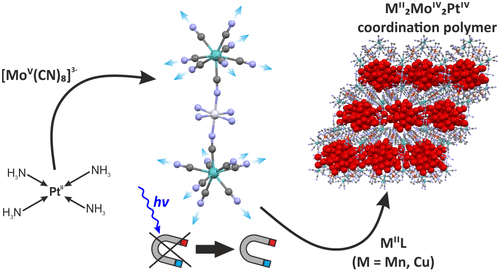当前位置:
X-MOL 学术
›
Inorg. Chem.
›
论文详情
Our official English website, www.x-mol.net, welcomes your
feedback! (Note: you will need to create a separate account there.)
Heterotrimetallic Cyanide-Bridged 3d-4d-5d Frameworks Based on a Photomagnetic Secondary Building Unit.
Inorganic Chemistry ( IF 4.3 ) Pub Date : 2020-06-08 , DOI: 10.1021/acs.inorgchem.0c00737 Michał Magott 1 , Marcin Sarewicz 2 , Szymon Buda 1 , Dawid Pinkowicz 1
Inorganic Chemistry ( IF 4.3 ) Pub Date : 2020-06-08 , DOI: 10.1021/acs.inorgchem.0c00737 Michał Magott 1 , Marcin Sarewicz 2 , Szymon Buda 1 , Dawid Pinkowicz 1
Affiliation

|
The rational design of coordination frameworks combining more than two different metal ions using a self-assembly approach is challenging because it rarely offers sufficient control over the building blocks at the actual self-assembly stage. In this work, we present a successful two-step strategy toward heterotrimetallic coordination frameworks by employing a new bimetallic [(NC)7MoIV-CN-PtIV(NH3)4-NC-MoIV(CN)7]4– secondary building unit (SBU). This anionic moiety has been isolated and characterized as a simple salt with an organic dppipH22+ cation (dppipH2)2[(NC)7MoIV-CN-PtIV(NH3)4-NC-MoIV(CN)7]·15H2O (1) (dppip = 1,4-di(4-pyridinyl)piperazine). The salt presents a second-order phase transition related to cation conformational change around 250 K and a photomagnetic effect after irradiation with 450 nm light at 10 K. When combined with aqueous solutions of MnII or CuII complexes, it forms either a one-dimensional chain [MnII(dpop)][MnII(dpop)(H2O)][(NC)7MoIV-CN-PtIV(NH3)4-NC-MoIV(CN)7]·36H2O (2) (dpop = 2,13-dimethyl-3,6,9,12,18-pentaazabicyclo-[12.3.1]octadeca-1(18),2,12,14,16-pentaene) or a photomagnetic two-dimensional honeycomb network [CuII(cyclam)]2[(NC)7MoIV-CN-PtIV(NH3)4-NC-MoIV(CN)7]·40.89H2O (3) (cyclam = 1,4,8,11-tetraazacyclotetradecane), both characterized by very large cavities in their structure filled with solvent molecules. Both 2 and 3 incorporate three different transition-metal ions and constitute a new family of 3d-4d-5d coordination frameworks. Moreover, compound 3 inherits the photomagnetic properties of the MoPtMo SBU.
中文翻译:

基于光磁辅助建筑单元的三金属氰化物桥接3d-4d-5d框架。
使用自组装方法结合两个以上不同金属离子的协调框架的合理设计具有挑战性,因为它很少在实际的自组装阶段对构建基块提供足够的控制。在这项工作中,我们通过采用新的双金属[(NC)7 Mo IV -CN-Pt IV(NH 3)4 -NC-Mo IV(CN)7 ] 4–向异三金属配位框架提出成功的两步策略二级建筑单元(SBU)。已分离出该阴离子部分,并表征为与有机dppipH 2 2+阳离子(dppipH 2)形成的简单盐。2 [(NC)7 Mo IV -CN-Pt IV(NH 3)4 -NC-Mo IV(CN)7 ]·15H 2 O(1)(dppip = 1,4-二(4-吡啶基)哌嗪。该盐表现出与250 K附近的阳离子构象变化有关的二级相变,以及在10 K下用450 nm光照射后的光磁效应。当与Mn II或Cu II配合物的水溶液结合时,它会形成一尺寸链[Mn II(dpop)] [Mn II(dpop)(H 2 O)] [(NC)7 Mo IV -CN-PtIV(NH 3)4 -NC-Mo IV(CN)7 ]·36H 2 O(2)(dpop = 2,13-二甲基-3,6,9,12,18-五氮杂双环-[12.3.1] octadeca -1(18),2,12,14,16五烯)或光磁二维蜂窝网络[铜II(cyclam)] 2 [(NC)7沫IV -CN -铂IV(NH 3)4 - NC-Mo IV(CN)7 ]·40.89H 2 O(3)(cyclam = 1,4,8,11-四氮杂环十四烷),其特征均是在结构中充满了溶剂分子的大空腔。都2和3结合了三种不同的过渡金属离子,构成了3d-4d-5d配位框架的新家族。此外,化合物3继承了MoPtMo SBU的光磁特性。
更新日期:2020-07-06
中文翻译:

基于光磁辅助建筑单元的三金属氰化物桥接3d-4d-5d框架。
使用自组装方法结合两个以上不同金属离子的协调框架的合理设计具有挑战性,因为它很少在实际的自组装阶段对构建基块提供足够的控制。在这项工作中,我们通过采用新的双金属[(NC)7 Mo IV -CN-Pt IV(NH 3)4 -NC-Mo IV(CN)7 ] 4–向异三金属配位框架提出成功的两步策略二级建筑单元(SBU)。已分离出该阴离子部分,并表征为与有机dppipH 2 2+阳离子(dppipH 2)形成的简单盐。2 [(NC)7 Mo IV -CN-Pt IV(NH 3)4 -NC-Mo IV(CN)7 ]·15H 2 O(1)(dppip = 1,4-二(4-吡啶基)哌嗪。该盐表现出与250 K附近的阳离子构象变化有关的二级相变,以及在10 K下用450 nm光照射后的光磁效应。当与Mn II或Cu II配合物的水溶液结合时,它会形成一尺寸链[Mn II(dpop)] [Mn II(dpop)(H 2 O)] [(NC)7 Mo IV -CN-PtIV(NH 3)4 -NC-Mo IV(CN)7 ]·36H 2 O(2)(dpop = 2,13-二甲基-3,6,9,12,18-五氮杂双环-[12.3.1] octadeca -1(18),2,12,14,16五烯)或光磁二维蜂窝网络[铜II(cyclam)] 2 [(NC)7沫IV -CN -铂IV(NH 3)4 - NC-Mo IV(CN)7 ]·40.89H 2 O(3)(cyclam = 1,4,8,11-四氮杂环十四烷),其特征均是在结构中充满了溶剂分子的大空腔。都2和3结合了三种不同的过渡金属离子,构成了3d-4d-5d配位框架的新家族。此外,化合物3继承了MoPtMo SBU的光磁特性。











































 京公网安备 11010802027423号
京公网安备 11010802027423号